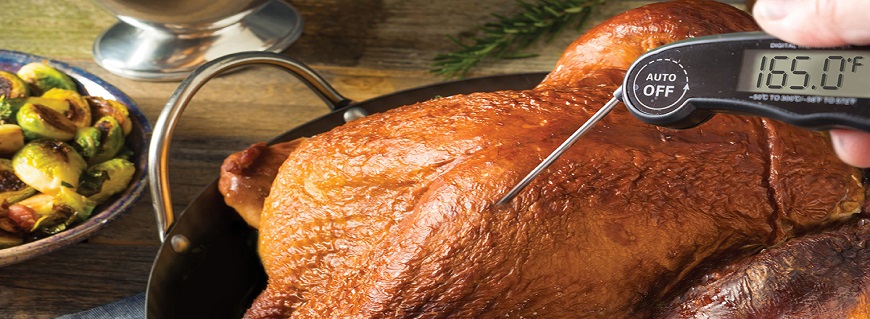
Whether you're a seasoned chef or preparing your first holiday meal, it is important to know the safest ways to thaw, prepare, stuff, cook, cool and reheat your holiday turkey.
Foodborne illness is never pleasant; by safely preparing your food, you can reduce the risk of making you and your guests ill. Here are simple tips that all cooks in the kitchen can follow this holiday season to cook a delicious and safely prepared turkey.
Turkey Basics: Safely Thaw, Prepare, Stuff, Cook, Cool and Reheat.
When preparing a turkey, it's important to know the main safety issues involved with thawing, preparing, stuffing, cooking, cooling and reheating.
Safe Thawing: Never defrost a turkey on the counter.
- Turkeys must be kept at a safe temperature - below 45 degrees Fahrenheit - when thawing.
- There are three safe ways to thaw food:
- in the refrigerator, for up to a week, depending upon the weight. This is the safest and most
practical way to defrost a turkey.
- under cold, running tap water. Never stagnant or standing water!
- in a microwave
- See instructions for each method.
Safe Preparation
- After working with raw poultry, always wash your hands, utensils and work surfaces thoroughly with soap before touching and preparing other foods. Frequent handwashing by the chef is the key to safe food handling.
- To avoid cross contamination, use a separate cutting board for all raw meat and poultry preparation, and keep raw turkey away from vegetables and side dishes that won't be cooked.
- Always prepare and serve food on clean plates - not those previously holding raw meat and poultry. This prevents bacteria from raw poultry from cross contaminating other food.
Safe Stuffing
- For optimal safety and uniform doneness, cook the stuffing outside the turkey in a casserole dish.
- If you do place stuffing inside the turkey, do so just before cooking - NEVER OVERNIGHT! Be sure to use a 0 to 220 degree food thermometer to confirm that the center of the stuffing reaches a safe minimum internal temperature of 165 degrees Fahrenheit in order to kill any potential bacteria.
Safe Cooking
- Set the oven temperature no lower than 325° F. Pre-heating is not necessary.
- Be sure turkey is completely thawed. Cooking times are based on fresh or completely thawed birds at a refrigerator temperature.
- Place turkey breast-side up on a flat wire rack in a shallow roasting pan, 2 to 2 ½ inches deep.
- For safety and uniform doneness, it is recommended to cook stuffing outside the bird. If stuffed, place dressing loosely into cavity just before turkey goes into the oven.
- The internal temperature should be checked with a meat thermometer and must reach a minimum of 165° F. Check the temperature in the innermost part of the thigh and wing, and the thickest part of the breast before removing it from the oven. The center of the stuffing should reach 165° F for at least 15 seconds.
- Juices should run clear.
- Time your meal to go from the oven to the table. Serve it hot!
- Arrange and serve food on several small platters rather than on one large platter. Keep the rest of the food hot in the oven (set at 200° F – 250° F) or cold in the refrigerator until serving time. This way food will be held at a safe temperature for a longer period of time. REPLACE empty platters rather than adding fresh food to a dish that already had food in it. Many people’s hands may have been taking food from the dish, which has also been sitting out at room temperature.
- Divide cooked foods into small shallow containers to store in the refrigerator or freezer until serving. This encourages rapid, even cooling. Do not stack the containers until refrigeration temperatures are reached. Reheat hot foods to 165° F for at least 15 seconds, rolling boil for gravy, sauces, and soups.
For more information on safe internal temperatures, visit FoodSafety.gov's Safe Minimum Cooking Temperatures.
Safely Cool Leftovers
- Leftover turkey, stuffing, etc., needs to be refrigerated within two hours from the time you remove the turkey from the oven.
- Soups and stocks should be cooled in the refrigerator, uncovered in shallow pans. They can be transferred to large, covered vessels after reaching refrigerator temperature.
- Avoid filling containers with food deeper than four inches and then stacking multiple containers on top of each other until the food has cooled to under 45 degrees Fahrenheit.
Safely Reheat Leftovers:
- Leftovers, including turkey meat, stuffing and stock should be reheated to at least 165 degrees Fahrenheit before serving.
- Always use a 0 to 220 degree probe thermometer to check the temperature of reheated food.
Resources:
- USDA Meat and Poultry Hotline: (888) MPHotline (888-674-6854)
- Food Safety (CDC)
- Is Pink Turkey Meat Safe? (CDC)
- Alternative Ways to Cook Turkey - How to grill, smoke, microwave, and deep fat fry turkeys.
- Turkey Roasting Chart
